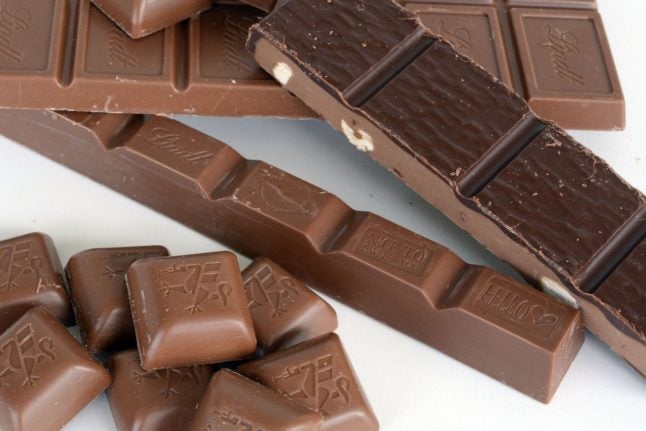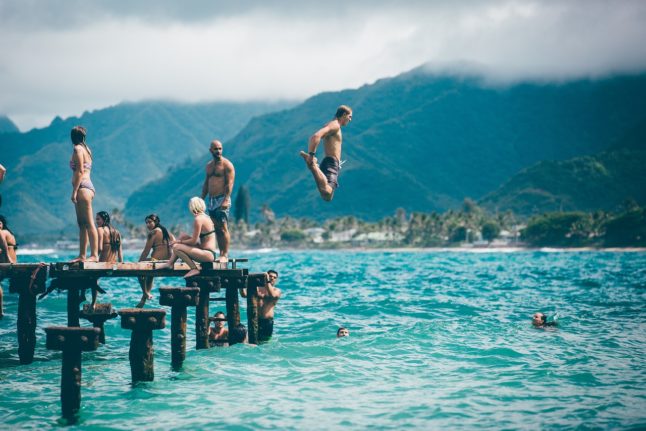Swiss people living abroad often ask for souvenirs from visitors that remind them of their homeland – and if you’re a veteran Swiss, this will almost always include a few bars of Ragusa.
Today, Chocolats Camille Bloch – which produces Ragusa – is one of the largest chocolate manufacturers in Switzerland and produces some 3,700 tons of chocolate goodness annually, of which roughly 20 percent is exported.
How it began
Ragusa was first created in 1942, during the war years when raw materials – like cocoa – were in short supply.
But this didn’t stop chocolatier French citizen Camille Bloch who emigrated to Switzerland from France with his family in circa 1850. The Blochs – who had Jewish ancestry – settled in Bern where Jews had the right to remain, and Bloch went on to do an apprenticeship at Chocolat Tobler in the city.
After he became naturalised and completed his military service in Switzerland, Bloch founded his own chocolate factory, the Chocolats et Bonbons Fins Camille Bloch, later known simply as Chocolats Camille Bloch SA, in 1929.
First thing to do when you arrive to Switzerland ➡️ Get some @Ragusa_DE pic.twitter.com/VUxMKVlUoc
— Emma (@eemmaae114) October 20, 2016
Though cocoa was scarce during the 1940s, Bloch was determined to create his very own chocolate. In order to succeed in making his creation a commercial success, he used a mass of ground hazelnuts mixed with whole hazelnuts between two thin layers of dark chocolate to create Ragusa in 1942.
The chocolate and the mixed mass of hazelnut goodness were then poured in consecutive layers into flat moulds before being cut into rectangular bars of 50 grams, as was the initial shape of the Ragusa chocolate.
The recipe also included cocoa fat, cocoa butter, unhardened vegetable fats (no trans fats), powdered milk and sugar (both from Switzerland) and natural vanilla (from Madagascar).
READ MORE: Why are the Swiss so obsessed with Aromat?
Commercial success
Now Bloch just needed to find a name that would transcend Switzerland’s four language regions, and this was no easy feat. Luckily, he had recalled his visit to the Croatian town of Ragusa – now Dubrovnik – and found the ring of the name to be a good fit.
Next came the packaging in 1945, which initially featured the brand name – Ragusa – alongside the company name Camille Bloch and two hazelnuts. The packaging was slightly updated but remained largely the same in 1960 and received its first televised commercial – in black and white – in 1965.
Two years after the first colour television was introduced, Ragusa premiered its first colour television commercial in 1975. Five years later, in 1980, Bloch took marketing to new heights with a Ragusa-shaped hot air balloon being sent off into the sky on national TV.
More TV advertising and packaging remakes followed, and Ragusa soon became a staple in Swiss households across the country.
Gift number two – Ragusa from Switzerland! 😍 pic.twitter.com/3p25NnTKF0
— SNS (@SNSalgado) June 1, 2015
The essence of Ragusa itself remains largely unchanged, from the same recipe, to the same method of manufacturing with traditional confectionery quality and the rectangular chocolate shape.
Today, the grandson of Camille Bloch, Daniel Bloch, acts as managing director of the distinguished chocolate firm and has made it his mission to elevate the brand’s success and take it across the border to Germany.
In 2008, Ragusa Noir – the dark chocolate version of the chocolate bar – came onto the scene and in 2014, Ragusa fans were delighted with yet another addition: Ragusa Blond.
The latter proved particularly popular with the younger generation as did Ragusa McFlurry, which was added to McDonald’s dessert menu after the food chain reached out to Camille Block directly to collaborate.
While the traditional size of a Ragusa bar was originally 50 grams, the chocolate is now also available in 25 and 11 grams.
READ MORE: Le Parfait: How Switzerland fell in love with a pork liver spread
Ethical production
Ragusa is for the most part ethically produced using cocoa from Peru where cocoa cultivation is a tradition and infrastructure is stable.
Camille Bloch’s supplier also ensures that the cocoa is not harvested in deforested regions and that no child labour is involved in its production.
As for the almonds, Bloch sources their almonds from ethically accredited producers in the USA and their hazelnuts from producers in Turkey, who are also ethically accredited.
In the future, the company plans to cover its hazelnut requirements itself and thus began an innovative sustainable development planting programme of its own hazelnut trees in Georgia in 2021.



 Please whitelist us to continue reading.
Please whitelist us to continue reading.
Member comments